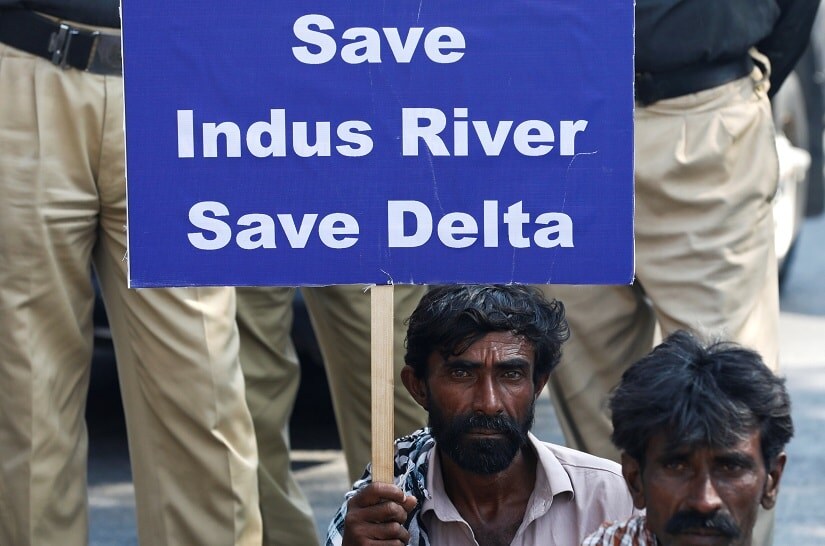In our previous column, we saw how the Indus Waters Treaty (IWT)
defanged the dam as a geopolitical source of advantage . But the more relevant question to ask is — will securing the Indus secure India’s water future? To answer that question, we need to understand what use the water is put to. The largest use of water on both sides of the border is agriculture. From IWT to now: Addicted to water-hungry crops in a rain-starved region Since Punjab supplies food for the rest of India, it’s useful to consider the population growth of India as a driver for Punjab’s agricultural growth.
Since the Indus water plays a central role, let us ask a different question: Are the Indus waters secure?
The Future: Climate Change and Changing Geopolitics The answer to the above question is, no. First, demand will continue to increase. Quite apart from rising populations and increasing wealth, climate change is expected to increase water requirements by 5-15 percent by 2047 in Pakistan. It’s fair to say the number will be similar in India. Fights are breaking out — not between countries, but within each country: Sindh vs Punjab (Punjab dwarfs Sindh in water withdrawals) contrasted with Haryana vs Delhi. Somewhere, someone is sporting an ironic smile. [caption id=“attachment_6398761” align=“alignnone” width=“825”]  Fisherfolk in Pakistan at a ‘Save Indus’ demonstration in October 2018. REUTERS[/caption] Second, we have a new participant in this game. Let’s not forget that China is beginning to get into the Indus game: first by building a dam in its own territory, and then by financing a set of dams in Pakistan. Any future negotiation in the Indus will have, tacitly or overtly, a Chinese cast. Third, the waters themselves will become more volatile. The Indus waters look to become far more uncertain as the climate warms. There are several studies that show rising temperatures will melt glaciers faster. This is important because the glacier melt runoff contributes a significant proportion of the river flow. But to understand the overall state of river flow, we need to consider the impact of snowfall in catchment areas as well. Putting all this together, studies appear to suggest that annual runoff may increase in the short term, but likely decrease in the longer term. Something to keep in mind, when we construct dams in that area. It also appears likely that the volatility between and within years is likely to increase. Floods and droughts? Build more dams, some might suggest. As we rush to build yet more dams in the name of flood control, it maybe prudent to consider whether they are up to a job in a climate that is changing all too rapidly. Set our own house(s) in order: Management vs Provision Fairly soon, we will be confronted with a choice regarding our water future. It’s easy to say that ‘turn off the tap’ or ‘build a wall’. But the soundest way of securing our water future is managing our water present. Water pricing is beginning to take tentative steps forward in India. And communities which have run out of both ground and municipal water are discovering the glories of sewage. So focussed have we been on the seasonal Indus waters, that we tend to forget that both countries have ample access to a secure, non-seasonal, plentiful, (relatively) untapped source of water — sewage. The total quantity of sewage produced in the Punjab may not satisfy its thirsty farms, but it can help a little. What are Punjab’s options to optimise water use? Stop procurement of paddy. Not possible. Not even conceivable. But perhaps we should start thinking about how to ‘sour the milk’. Replacing food subsidy by a universal basic income is one possibility. Price power for agricultural pump sets. Not possible. Again, replacing the power subsidy with a universal basic income is a possibility. Treat sewage to supply agriculture. Hmmm. This is one intervention that may be politically (and economically) feasible, especially if done in a decentralised fashion.
If each country strengthens its own water hands, the need to squabble over a tap on an uncertain river comes down.
Almost two centuries ago, the British prioritised provision of water in the Punjab via the canals over local management . Today, we face a similar choice: focus on provision and face an uncertain future or focus on management and secure that future. Ironically, since both countries are democracies, it is up to the people to elect political parties based on their water management policies. Today, we don’t. But will we tomorrow? The writer is the founder of the Sundaram Climate Institute, cleantech angel investor and author of The Climate Solution — India’s Climate Crisis and What We Can Do About It published by Hachette. Follow her work on her website; on Twitter; or write to her at cc@climaction.net.


)

)
)
)
)
)
)
)
)



